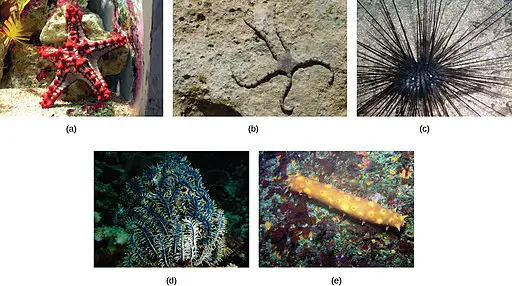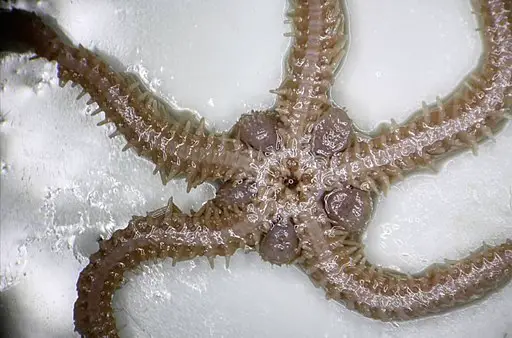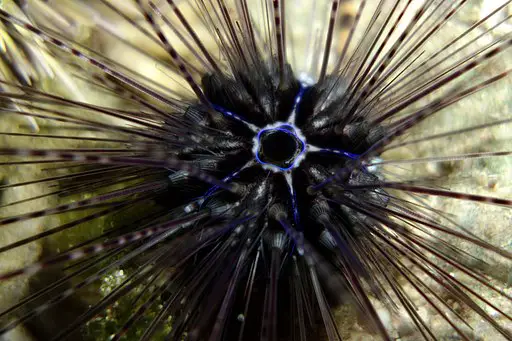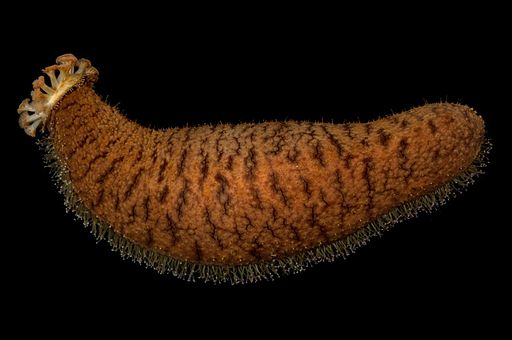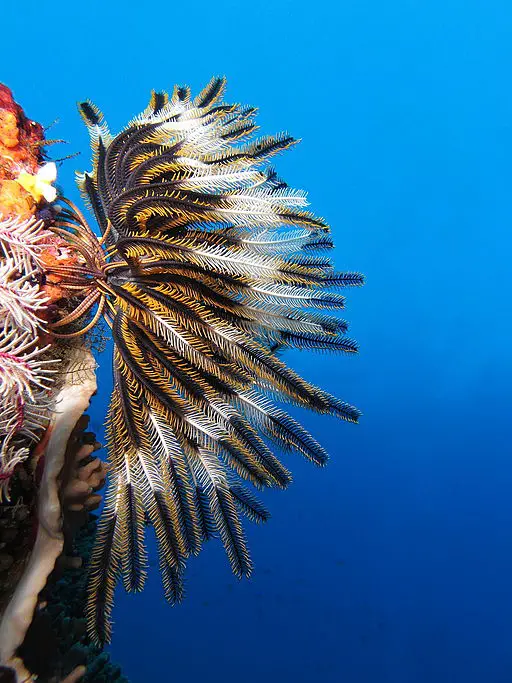Phylum Echinodermata
Classification and Characteristics
* The name Echinodermata is derived from the Greek words "Echinos" meaning hedgehog and "Derma" which means skin.
The phylum Echinodermata consists of "spiny-skinned" animals that are commonly found in oceans (the majority of species are marine). Today, there are an estimated 7,000 living species distributed in all oceans throughout the globe. Based on fossil records, over 13,000 species have gone extinct.
Though the group initially comprised a few star-shaped animals, many more organisms of varying shapes and sizes have been added over the years. However, they all share a number of basic characteristics including the lack of a distinct head and radial symmetry in adults, etc.
Phylum Echinodermata Classification
Domain: Eukarya - Members of the phylum Echinodermata belong to the domain Eukarya. As such, they are eukaryotic organisms (cells consist of membrane-bound organelles).
Kingdom: Animalia - Echinodermata species are all animals. As such, they are heterotrophic, multicellular, and capable of movement. Compared to plants, their cells do not have a cell wall.
Phylum: Echinodermata - Members of this group are characterized by an internal skeleton made up of ossicles (spiny plates), a water-vascular system, and tube-like feet.
Class: The phylum Echinodermata is divided into five (5) main classes that will be discussed in detail.
Some members of the phylum Echinodermata include:
· Stichopus chloronotus
· Labidiaster annulatus
· Anasterias antarctica
· Diplasterias brandti
· Granaster nutrix
· Odontaster validus
· Ophionotus victoriae
General Characteristics of Echinoderms
As mentioned, the phylum Echinodermata consists of approximately 7,000 living species. Though they were all assumed to be exclusively marine, only found in all world's oceans, a few species have been detected in brackish waters, those with varying salinity levels. In the oceans, these organisms can be found at varying depths; from shallow waters to the ocean floor - Adult forms have radial symmetry and may range between 1 cm and over 2 meters wide depending on the species.
They also have an internal skeleton that is primarily made up of ossicles consisting of calcium carbonate and a few proteins. While the ossicles that make up the internal skeleton provide structural support, they are not entirely solid. Rather, they have a sponge-like general structure known as stereom.
All echinoderms also have a water vascular system that consists of a network of radial canals. This is an important system that serves a number of important functions including feeding and locomotion etc.
Characteristics
In order to understand the characteristics of Echinoderm species, it's important to look at the five major classes in this group.
These include:
Class Asteroidea
The class Asteroidea consists of over 1,900 species commonly known as Sea Stars. They are widely distributed throughout the world including the Antarctic region. In the marine environment, they can be found at various depths from the intertidal zone to the sea/ocean floor where they live on soft sediment surfaces or rocks.
Characteristics of Sea Stars (Asteroidea)
Morphology
The majority of sea stars are small in size, ranging from less than an inch to over 40 inches in width (radius). For instance, whereas the species Granaster nutrix is about 0.4 inches in radius, the species Labidiaster annulatus can grow to be over 20 inches:
Some species like Pyconopodia can grow to be over 1 meter in diameter. Depending on the species, they may be brightly covered with colors ranging from red (e.g. Some Perknaster species) and blue to orange/yellow (e.g. Neosmilaster georgianus and Granaster nutrix) and grey.
Though most of the species have five rays/arms thus exhibiting pentaradial symmetry, radiating from the central disk such as Anasterias antarctica, some, like Labidiaster annulatus, may have as many as 50 rays. Emerging from these arms/rays (as the oral side of the disc) are numerous tube feet (hundreds).
These tube feet normally extend to attach to the substrate and then contract in an alternative fashion allowing the organism to move from one point to another. For some of the species, e.g. Ophiuroids; the tube-feet do not extend from the tube-foot groove. For this reason, movement is made possible by an oar-like movement of the arms.
The oral opening (mouthpart) is located on the oral surface on one side of the central disk. It's surrounded by spines that emerge from the internal skeleton. The mouth is connected to the large stomach (divided into the cardiac stomach and pyloric/aboral stomach) by a short esophagus and fills most of the coelom.
During feeding, the stomach may extend outwards in most species, e.g. in Diplasterias, allowing the animal to swallow sediments or prey. Here, the tube feet contribute to holding the prey. Sea stars feed on a variety of organisms including mollusks, crustaceans, and krill, etc.
* While some of the species like Stegnaster inflatus are highly specialized predators and prey on organisms like worms and some cnidarians etc., many, like Patiriella regularis, are opportunistic feeders and will often feed on any prey that happens to be under them.
The water-vascular system of these organisms consists of a number of important structures including the lateral canal, radial and ring canal, the stone canal as well as the madreporites. Radial canals originate from the ring canal and extend into each arm.
The radial canals, in turn, open to the body cavity through the stone canals which consist of the madreporites. Some internal organs/structures include the gonads, radial nerve, ampulla, and pedicellaria, etc.
Reproduction
The majority of Asteroidea species are dioecious (separate sexes). Gonads can be found on each arm and have been shown to enlarge during reproduction. Here, gametes are usually released into the surrounding for external fertilization.
In a few species, however, fertilized eggs and juveniles may be contained in the mouth, stomach, or other specialized regions. Following fertilization, the embryos produced tend to be planktonic and normally use cilia for swimming. Over time, however, they develop into bilaterally symmetrical larvae. These larvae feed on protists in their surrounding as they develop into juvenile Echinoderms.
Some of the other characteristics associated with sea stars include:
· Gaseous exchange and excretion of waste is achieved through diffusion. Here, the action of ciliated cells along the body cavity has been shown to promote the diffusion of gases, nutrients, and various wastes through the dermal brachiae and tube feet among other membranous parts. Undigested food materials are generally removed through the mouth given that the anus is poorly developed and virtually nonfunctional.
· They have a simple nervous system that consists of the nerve ring around the oral opening and radial nerves that run into each arm. They also possess sensory receptors on their body surface which allows them to respond to various stimuli (light, chemicals, etc.)
· They are capable of regeneration and can therefore regenerate some lost body parts like the arms
* Though most sea stars are dorso-ventrally flattened, others may be heavily inflated or even spherical in shape.
* The tube feet have suction disks that enhance attachment.
Some examples of species within the class Asteroidea include:
· Anasterias antarctica
· Diplasterias brucei
· Neosmilaster georgianus
· Psilaster charcoti
· Acodon-taster hodgsoni
· Odontaster validus
· Macroptychaster accrescens
· Labidiaster annulatus
Class Ophiuroidea (Basket Stars and Brittle Stars)
* The name Ophiuroidea is derived from the Greek words "Ophis" meaning snake and Oura which means tail (as well as Oeides meaning the form of).
The class Ophiuroidea consists of over 2,000 species collectively known as Ophiuroids. With so many species, the class Ophiuroidea is one of the most diverse groups of marine organisms. In the oceans and sea, they are commonly found living in the rock and coral crevices or clinging to algae.
Most of the species have mottled/banded color patterns while some of the species have very bright colors making it easy to identify them.
Characteristics of Ophiuroidea
Morphology
Like most members of the class Asteroidea, Ophiuroids have a dorso-ventrally flattened body with a round or pentagonal central disc. Compared to Asteroidea species, however, Ophiuroids usually have long, sharply demarcated arms that can be over 20 times the diameter of the central disc. In some of the basket star species, these arms are branched giving them a fork-like appearance (E.g. Astrophyton muricatum).
In brittle stars, e.g. Ophionotus victoriae and Ophiopholis aculeta, the arms are unbranched and the central disk may range between 1 to 3 cm in diameter. Because of their extended length, these arms are able to move more freely in a snake-like manner.
Though they have tube feet on their arms, these feet do not have suction disks. However, like those of Asteroidea, they can extend as a result of muscle contraction. Given that the long arms can be used for crawling along a surface, the water vascular system in these organisms is not used for locomotion.
The ossicles, which form the modified skeleton originate on the aboral surface and cover both the lateral and oral surfaces of the arms. For this reason, the body is completely covered by calcified plates of the skeleton. Modification of the skeleton makes it possible for the arms to move freely. The oral opening/mouth is also located at the lower, central part of the central disk. It consists of five triangular jaw-like structures used for chewing.
Food material from the mouth are directly passed to the stomach (a sac-like structure) in the coelom. Ophiuroids do not have an intestine. During feeding, plankton trapped in the tube feet are passed along the length of the arm and from one foot to another until they reach the mouth.
Given that the stomach is located in a small coelom, coelomocytes play an important role in the distribution of nutrients as well as the expulsion of waste material . These materials, e.g. nitrogenous waste products, are eventually released across the tube feet and bursae through diffusion.
* Like the stomach, the gonads are also located in the central disk in most species.
* In the oral disk, there are slits that allow cilia to move water in and out of the bursae.
* In some species, male Ophiuroids have been shown to be smaller than females. However, for the most part, it's difficult to distinguish between male and female individuals.
* Species in this group greatly vary in size; the central disk varies from half a centimeter to over 10 centimeters in diameters - The arms can be 20 times the length of the central disk.
Reproduction
Ophiuroids are dioecious animals which means that there are separate male and female individuals. During sexual reproduction the eggs may be released into the surroundings to be fertilized externally or retained within the bursa where fertilization may also occur.
In the bursa, the fertilized eggs are protected from external elements as they develop. Over time, the embryo gives rise to the larva (Ophiopluteus) which is planktonic (pelagic larva). The larva then undergoes metamorphosis giving rise to benthic adults and the process repeats.
* Like Asteroidea species, Ophiuroids are also capable of regeneration. In a scenario where the arm of a brittle star has been grasped, studies have shown the contraction of certain muscles to cause the arm to be severed. Over time, however, the animal can regenerate a new, functional arm.
Some members of this group include:
· Ophiactis
· Ophionereis
· Amphiophiura
· Ophiurolepis
· Cryptopelta
· Astroniwa
Class Echinoidea
The class Echinoidea consists of sea urchins, heart urchins, and sand dollars. There are about 1,000 living Echinoidea species which can be found in marine environments. Some of the species can be found on rocky shores (regular sea urchins) while other members of the group (sand dollars and heart urchins) live at the bottom of the sea (depths of about 6,000 meters).
Characteristics of Echinoidea
Morphology
Echinoids are generally small in size, measuring between 3 and 10 cm in diameter. However, a few can grow to over 15 cm. Depending on the species, they may be brightly colored and conspicuous. Compared to some of the other members of the phylum Echinodermata that are dorso-ventrally flattened with elongated arms, Echinoids are armless and may be spherical or discoidal in shape (some of the species are flattened).
Their endoskeleton, known as a test, is also different in that it consists of about 10 fitting plates that interlock at the edges (and arch between the oral and aboral ends). The endoskeleton also has openings through which the tube feet emerge. Though they lack arms, these organisms have spines that may be hollow and sharp. At the base of each spine is a concave socket with muscles (these muscles move the spines). Depending on the species, the spines may contain venom.
In all Echinoids, the spines (together with the tube feet) are used for movement. While tube feet are used for pulling, the spines serve to push against the substrate as they move. In some of the other species, however, the spines are used to burrow into various surfaces.
In addition to the spines and tube feet, their surfaces are also equipped with pincer-like structures known as pedicellariae (with 2 or 3 jaws) that serve to remove debris or for protection from prey. With the set of jaws (connected to the body through a slender stalk), they can easily remove any debris on the body surface or capture some prey. In some sea urchin species, the pedicellariae have also been shown to contain venom which they can inject into the predator to protect themselves.
The oral opening is usually located at the underside of the organism while the anus is located at the terminal or aboral side. The mouth consists of a chewing apparatus, consisting of a set of jaws/ossicles and muscles, known as Aristotle's lantern. In some of the species, this apparatus is used for burrowing.
The mouth connects to a long and coiled intestine through the pharynx and esophagus. Food material (algae, dead animals, and coral polyps, etc.) are first chewed in the mouth before being passed to the pharynx and esophagus. Digestion occurs in the intestine and waste material expelled through the anus at the aboral end.
* The intestines are located in the coelom.
* Gas exchange is through diffusion. This occurs through the epithelium and tube feet.
* The coelomic fluid (in the coelom) serves as the circulatory medium.
* The 2-5 gonads are also contained in the coelom.
* Like other Echinoderms, the water-vascular system of these species consist of radial canals that runs into the body wall.
Reproduction
Like many in the class Echinodermata, Echinoids are dioecious. During the reproduction period, they have been shown to increase in size almost filling the coelom. Gametes are normally released into the surroundings and fertilization occurs externally. Over time, the embryo develops into a larva (pluteus larva) which spends several months of its life feeding on plankton before undergoing metamorphosis to transform into an adult.
* Sea urchins can regenerate several parts of their bodies including the spines, pedicellariae, and parts of the test.
Some members of the class Echinoidea include:
· Evechinus chloroticus
· Fellaster zelandiae
· Apatopygus recens
· Echinocardium cordatum
· Gymnopatagus parvipetalus
· Kermabrissoides siculum
Class Holothuroidea (Sea Cucumber)
The class Holothuroidea consists of over 1,500 species commonly known as Sea Cucumbers. They can be found at various depths of the ocean where they either burrow into soft substrates or crawl over various substrates.
* Sea cucumbers range from 10 to 30 cm in length.
Characteristics of Holothuroidea
As the name suggests, Holothurians have an elongated body (along the oral-aboral axis). Though they have a cylindrical shape, the ventral side is normally flattened and serves as the side on which they lie.
Unlike most Echinoderms, Holothurians do not have arms and have a reduced skeleton (made up of calcareous plates). However, they have a number of features common to all Echinoderms including tube feet, a mouth, and the water vascular system.
The mouth part/oral opening is surrounded by modified tube feet which act like tentacles in some species often used to capture food. However, the tube feet on the rest of the body are used for movement. Here, the tube feet can adhere and detach from surfaces allowing the organism to move across surfaces or hold onto substrates. The mouth is connected to a long, coiled intestine through the esophagus. The intestine ends in the cloacae.
The water-vascular system in sea cucumbers is filled with coelomic fluid and the madreporite is internal. The ring canal of this system is located around the anterior part of the digestive tract and gives rise to the Polian vesicles. Radial canals and canals that run into the tentacles originate from the ring canal.
Some of the other characteristics of sea cucumbers include:
· Thick and muscular body wall
· Thick layer of connective tissue with embedded ossicles is located beneath the epidermis
· A calcareous ring of ossicles surround the oral end of the animals. This calcareous ring is attached to the body wall muscles
· Adults exhibit radial symmetry
· Majority of species are dioecious but some of the species have been shown to be hermaphrodites (capable of self-fertilization)
· Most species can produce toxins to defend themselves
Respiration
Sea cucumbers have a large coelom and cilia in this region that serve to circulate fluid in the body cavity. This is important for the distribution of gases and other materials. The body cavity also consists of a pair of respiratory trees that originate from the rectum.
Due to the pumping action of the rectum, water is circulated into this pair of tubes and only exits once the tubes contract This also serves an important role in the movement of respiratory gases and waste products between the coelom and water across the tubules.
Reproduction - As is the case with many other Echinoderms during reproduction, gametes are released into the water for external fertilization. The embryo formed develops into a planktonic larva that in turn undergoes metamorphosis to produce a juvenile that matures over time.
In some species, however, fertilization occurs in the body cavity with early development taking place here. Following the development, the juvenile individual leaves this cavity through a rupture in the body wall
* Some sea cucumbers are capable of asexual reproduction through transverse fission.
* Sea cucumbers are also capable of regenerating some lost body parts.
Some members of the class Holothuroidea include:
· Australostichopus mollis
· Paracaudina chilensis
· Heterothyone ocnoides
· Trochodota dunedinensis
· Protankyra brychia
Class Crinoidea
The class Crinoidea consists of sea lilies and feather stars that are collectively known as Crinoids. Today, there are over 630 living species that are found at varying ocean depths throughout the world.
Whereas sea lilies are usually restricted to the bottom of the sea, where they are attached to various substrates, feather stars can swim and crawl on various surfaces.
* Compared to the other species, members of the class Crinoidea are the most primitive members of the phylum Echinodermata.
Characteristics of Crinoidea
Morphology
The body of both sea lilies and feather stars consist of a cup-like calyx which consists of a series of plates (5 or more plates known as basals and radials). In addition to the series of plates, the calyx also consists of membranous tegmen and branched arms. These arms originate from the margins of the calyx as well as the tegmen.
Unlike feather stars, the sea lilies are permanently attached to substrates by a flattened disk or root-like extensions located at the end of a slender stalk (the stalk connects the calyx to the disk/root-like extensions). Like most other Echinoderms, the Sea lilies also have ossicles. Here, the ossicles are located on the stalk where they are held together by connective tissues. They also possess tube feet which are located along the length of each arm.
Unlike the sea lilies, the feather stars do not have a stalk. Rather, the aboral end of the calyx (crown) consists of numerous cirri. The animal clings on to surfaces by moving their arms up and down, which enables them to swim freely from one point to another. However, to crawl over substrates, they usually use the tips of their arms to attach and pull themselves in any direction.
The mouth part/oral opening is located on the upper side of the calyx (the oral side in these animals is at the top side of the cup/calyx). The mouth is surrounded by ambulacral grooves. These are important structures that carry food materials from the arms towards the mouth.
Generally, food particles are captured by tube feet (located on the arms and covered in sticky mucus). These particles are then moved into the ambulacral groove before being carried to the mouth.
* Crinoids are suspension feeders. As such, they depend on the elongated arms to trap food particles.
* The simple nervous system consists of a cup-shaped mass of nerves (at the base of the calyx) which gives rise to radial nerves that extend into the arms.
* The water vascular system in Crinoids is much simpler compared to those of other Echinoderms - Here, the arms also play an important role in respiration.
Reproduction - The majority of Crinoids are dioecious (separate male and female individuals). In most of the species, the gametes are released into the seawater where fertilization occurs (external fertilization). The embryo that is produced develops into the larva which in turn undergoes metamorphosis to give rise to a juvenile individual that matures over time.
Some members of the class Crinoidea include:
· Comanthus benhami
· Promachocrinus kerguelensis
· Florometra mawsoni
· Thaumatometra alternata
· Hypalocrinus naresianus
What does Phylum mean in Biology?
Return from phylum Echinodermata to MicroscopeMaster home
References
David Denning and Bruce Russell. (2005). Echinoderms.
Marc Eleaume, Peter Mark O'Loughlin, and Dirk Schories. (2016). Echinoderms, Echinodermata.
Nadia Ameziane and Niki Davey. (2007). Phylum Echinodermata: Sea-stars, Brittelstars, Sea Urchins, Sea Cucumbers,
Sea Lilies, and Kin.
Raj Khanna. (2006). Biology of Echinodermata.
Links
https://animaldiversity.org/accounts/Echinodermata/
https://www.digitalatlasofancientlife.org/learn/echinodermata/crinoidea/
Find out how to advertise on MicroscopeMaster!
